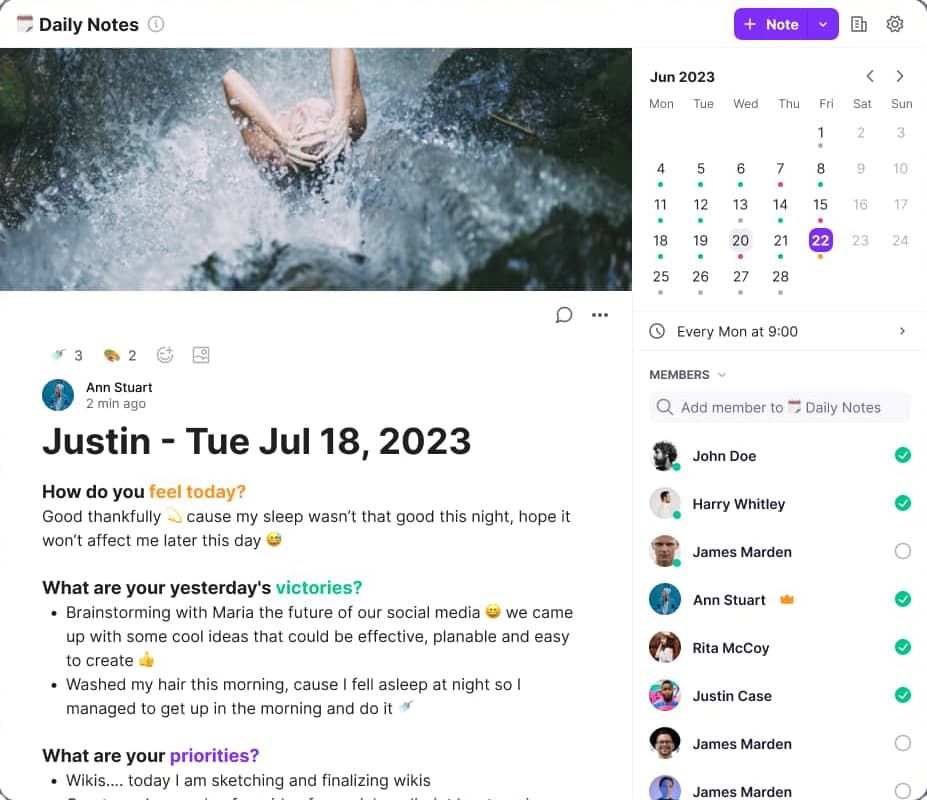

Asynchronous Daily Standups: Pros, Cons & Best Practices
Many companies have started using short daily “stand-up” meetings that usually take 15 minutes, with every team member updating by answering the following:
- What they did yesterday;
- What they’re doing today;
- What challenges they’re facing with current tasks.
It’s a simple approach and can work for some businesses, but in some cases, meetings need to be more involved. People often want to share more on discussed topics and can’t attend meetings consistently.
Simply put, if you cannot conduct short synchronous meetings consistently, it might be a good idea to go in a different direction. Whether you’ve tried a short standup format or feel it can’t work for your organization, you should consider asynchronousdaily standup meetings.
What is an asynchronous daily standup?
An asynchronous daily standup takes place without any real time interaction. Team members answer prepared questions and review their peers’ answers in an unblocked manner when they see fit. It’s a different form of communication that requires some time to get used to. There’s no fixed meeting time or check-ins.
All team members receive stand-up questions during a specific time of day and answer them online using some tool (usually a project management tool or a daily standup software ). Traditional synchronous daily standups appeared during the early 2000s. Even though this approach benefits many organizations, it’s too disruptive in a modern business environment.
That’s especially true when it comes to distributed and remote teams. The modern workplace is all about flexible schedules and hybrid workspaces. Modern business environments require a new approach. Hybrid teams also need a different meeting format.
Now, you might be wondering, what is the goal of asynchronous daily standups?
Asynchronous standups have the same goal as synchronous ones. It’s all about updating everyone on current tasks, challenges, and priorities. The critical difference is that asynchronous meetings don’t require everyone to meet physically or online simultaneously.
Like other meeting formats, asynchronous standups should include a goal and daily standup agenda . Asynchronous standups try to achieve the same goals while putting fewer obligations on your employees and allowing them to share async status updates on their own time.
Async communication is suitable for agile development, software teams, and organizations of all sizes with collaboration challenges because they work remotely.
Benefits of running asynchronous daily standups
Even though these differences might seem minor, they change things significantly and bring many benefits. Here are some of the key benefits you should be aware of:
- Improved focus and no day-dreaming
Let’s be realistic. Employees often don’t have the energy and focus during standups. They think about their tasks and feel like meetings are wasting their time. At the same time, they can’t always quickly switch their focus on the meeting topics.
That usually results in daydreaming during meetings, and people drift off thinking about something else. With asynchronous standups, there’s less risk of people drifting off as they pick the best time when they’re composed to answer all the questions.
At the same time, even if someone has drifted off when reading other people’s updates, they can always go back and reread what others have said. It means employees can’t miss important dates and can refresh their memory.
- Better knowledge access and sharing
Daily standup tools used for asynchronous daily standups maintain the history of messages and data shared through channels. Simply put, all current and future team members can always use the platform to access all updates shared in any previous standup.
Instead of employees asking questions to standup leaders or other team members, they can be proactive and get the information they need on their own. Some of the best AI project management tools even have search capabilities, allowing teams to use the platform as a “standup knowledge base.”
Instead of having to memorize things like updates, bugs, or new features that were added, employees can always see what’s been done in the past.
- Improved team coordination
Having constant access to your project management platform and information shared and discussed during meetings reflects on your entire team. However, this information isn’t limited to team members only.
Product owners, managers, stakeholders, and anyone with access and interest can stay on top of the work done by viewing the information within project management channels. Many organizations need to coordinate carefully between teams, and with this centralized source of information and customizable team profile templates, you can quickly update other departments and coordinate with them on future steps.
- More suitable for remote teams/employees
Let’s face it. Modern organizations are flexible and work with teams or employees from different locations. When you have whole teams or individuals scattered across different time zones and locations, setting up meetings that work for everyone can be difficult.
With asynchronous daily standups, employees can provide their answers during the day, and others can look at their updates at a convenient time. There’s no need to log in to video conferences or attend a virtual meeting.
At the same time, there’s no potential for connectivity or other technical issues that might arise during meetings. A Remote worker can always check the answers the next day or when they’ve resolved technical difficulties.
- More workplace flexibility
Modern companies offer flexibility for a reason - employees demand this benefit. In fact, almost 60% of employees say that workplace flexibility is more important than other benefits, including salary. Asynchronous daily standups are another way to offer flexibility at work, especially when you have remote employees.
Instead of forcing people to rearrange their schedules to find the time needed for meetings, you are just giving them the freedom to choose when they want to respond to these questions. Employees can respond poorly to meetings, especially when they feel forced to attend them at a specific time.
- Everyone will be prepared for standups
A bunch of people are uncomfortable speaking in groups when everyone is listening to them. Just because someone doesn’t like meetings doesn’t mean they have nothing important to say or are bad at their work. Async daily standups let everyone express their voices equally.
At the same time, since employees get to pick when they want to answer their daily questions, they have the time to prepare. Everyone can read and share other status updates before they give their answers. That gives them confidence in what they’re doing and allows them to see how others have approached these meetings.
Challenges of asynchronous daily standups (+ how to solve them)
Even though asynchronous daily standups come with many major benefits, there are also challenges you must consider. Luckily, with the right approach and adjustments, you can overcome these issues. Regardless of the type of standups you’re using, working on them is crucial.
Team members failing to provide updates
Asynchronous daily standups give employees more freedom and autonomy. That’s generally good, but some people will simply forget about them or overlook their updates. It might sound like a funny problem, but when people stop contributing, the whole point of these meetings is lost.
Employees receive notifications through project management tools about updates, but it’s easy to ignore the notification and forget it later. In other words, this means you will have an unproductive meeting and miss the whole point of the async format.
A synchronous standup meeting can’t be avoided, and everyone can see when someone’s not present. But when people attend meetings online and engage in asynchronous communication, it’s easier to miss their obligations.
Solution : Leaders and project managers have access to modern project management tools that can send out multiple automated notifications reminding people of their concise updates. At the same time, you can create tables or cards where everyone can see each other’s updates for transparency so that people can remind each other of their updates.
No back-and-forth between team members
Asynchronous daily standups don’t take place in real time . Even though this is beneficial in some ways, it also creates challenges. Real-time meetings let employees interact, and there’s a constant back-and-forth between them.
Even though synchronous daily standups are very short, people still have room to discuss important issues. There’s no opportunity for doing this in typical asynchronous stand-up meetings, but leaders can enforce several mechanisms to allow important discussion.
Solution : Project management tools have various discussion boards, live feeds, or chat features you can use to set up ongoing discussions.
At the same time, managers can allocate time for meetings during which people can express their concerns, talk about issues, and clear up any misunderstandings. Managers must keep track of the issues mentioned or discussed and create separate meetings to address them with everyone involved.
Challenge/blockers aren’t addressed on time
In real-time standups where people communicate, individuals can talk about the issues they’re currently having. That subsequently leads to an additional discussion that takes place after the standup. Sometimes, managers will organize troubleshooting or look for answers on behalf of their team members.
With asynchronous meetings, the issues aren’t addressed right away. Sometimes, people won’t make a big deal about their problems as it might seem like they’re complaining.
Solution : Agile or scrum masters need to take the initiative and recognize important issues that should be addressed instantly. At the same time, they should talk to their employees about how virtual it is to talk about their major challenges and be diligent about updating everyone on the existing team. In addition, they can use various time management solutions, such as a time blocking template , to improve task scheduling and time management activities.
5 best practices to follow when implementing asynchronous daily standups
Asynchronous standups require preparation, proper execution, and a follow-up, just like in-person meetings. We will share five best practices to remember when organizing and managing asynchronous standup meetings to ensure your team is motivated, productive, and connected.
First of all, you should get feedback from your team. Creating a positive, healthy, and strong team culture starts by listening to your employees. If you want to see specific behavior from your employees, you should start by asking. Encourage team members to provide feedback constantly. An excellent place to start is to ask for feedback during daily standups.
That’s not performance feedback, and sharing thoughts during meetings is more impersonal, which is ideal for slowly building a culture where feedback is welcome. Perfecting your daily standups takes time, and if you want to get there faster, you should let everyone pitch in .
When you do asynchronous daily standups, send everyone a quick email or a feedback form where you can ask them to share thoughts on the process or specific aspects of your meetings. You should do this after two weeks of meetings and then whenever you see fit. Here are some common questions you can ask:
- Do you prefer synchronous or asynchronous standups, and why?
- Is there enough face-to-face time between the team?
- What do you think of this async meeting method?
Secondly, you should add synchronous communication where necessary. Although many people praise asynchronous daily standups, there’s no one-size-fits-all solution when it comes to meetings. If you want to make the most out of your asynchronous meetings, you should create a balance with synchronous communication. Human connection and human interaction are vital, and achieving them is one of the common challenges remote teams have.
For example, if you hold daily asynchronous meetings, you can add a single synchronous all hands meeting in real-time, during which people can share shoutouts, discuss important issues, and interact. You can also divide meetings into two segments, the first being asynchronous and the second in real time for interaction and going back and forth.
Thirdly, follow up on challenges/blocks your team is facing. When everyone has populated their stand-up meeting agenda with top priorities and key asynchronous updates, you will understand what everyone is working on that day. Given that the standup meeting format includes questions about roadblocks and challenges, you will also learn where to help team members.
Managers have a responsibility to help their employees and empower them so they can do their jobs more effectively and productively. Take the time to follow up with every team member and discuss the possible solutions for the problems or how these issues can be avoided.
You can either set up one-on-one meetings or message them separately and talk. Creating a dedicated space for people to discuss their biggest challenges helps you establish transparency and improve productivity overall.
Fourthly, you must set clear deadlines. Your team should understand expectations clearly when sharing updates and meetings. You should let people have the flexibility to deliver their responses any time they see fit as long as it’s before the deadline. For example, you can ask everyone to update their agenda by 11 a.m. the next day.
Adding a deadline improves accountability and creates a sense of urgency. People can often take asynchronous standups lightly, but this obligation becomes a route task they see as part of their jobs. Whether you’re using a project management tool or a meeting management app, encourage people to write questions and comments under others’ async standup updates.
Rather than interrupting each other, it’s better to have a structured asynchronous approach and rules so that everything can be documented and the whole team can access information whenever needed.
And last but not least, you should bring your team on board with asynchronous meetings. Start by helping people understand the differences between asynchronous and synchronous standups. Most people who work online haven’t even been involved in meetings and those who have usually participated in synchronous daily meetings only.
A significant difference you should highlight is that asynchronous meetings give more flexibility and time. Your team will appreciate that they don’t have to simultaneously walk into your conference room or log in to a video conference every day.
Everyone has different days and likes to organize their time effectively. Talk about the format, how it will work, what they can expect, and how it benefits everyone. Create daily standup meeting templates to make things familiar and get everyone used to the format.
Step up asynchronous daily standups with Ayanza

Using a powerful tool for your asynchronous daily standups is a must, and this is where Ayanza can help. First, this platform can facilitate meeting requirements like notes, chat, commenting, document sharing, analyzing data, and creating agendas.
But Ayanza takes things to a whole new level. Even though this is a project management tool, it can organize and manage standups. For example, this async standup tool has a powerful team management system to help you achieve goals and create coherence through rhythms, OKRs, strategy, and vision.
Ayanza has a Newsfeed feature that acts as a public channel that can be a great place where team members can quickly update each other, share information about overcoming challenges, and interact. That’s exactly where the asynchronous meeting format has issues, and it’s essential to address them.
Managers can create and share ad-hoc notes to provide solutions to individual challenges and even use the wiki as a knowledge base for all essential information. An AI-driven tool allows you to automate specific tasks and get more time to focus on your core tasks.
As we have established, asynchronous daily standups can help remote teams in many ways. Managers can keep track of team priorities and use the data to create a culture of communication and collaboration while boosting team morale. A strong employee connection is crucial if you want to grow as a team.
But before you use this method, look at your organization and employees to determine if this is the right approach for your teams. Once you’ve determined that, take the time to bring everyone on board.
FAQ
How can team members ensure effective communication in an asynchronous daily standup setting?
The first thing leaders must provide their agile teams is a robust standup management tool to facilitate communication. Give employees a communication channel they can use to talk to each other. On the other hand, encourage commenting, answering questions, giving feedback, and involving everyone to maintain communication at a high level.
Are there any tools or platforms that can facilitate asynchronous daily standup meetings?
Yes, there are many asynchronous tools you can use for a daily stand-up. Some include Ayanza, ClickUp, Stepsize AI, Geekbot, Slack, etc. Using the right technology to help you organize, structure, and manage standups effectively is crucial.
What role do time zone differences play in asynchronous daily standups?
Almost none and that’s the beauty of asynchronous daily standups. All employees have a deadline by which they have to fill out their agenda and share updates. The rest is up to them, and they can decide when they want to finish this task.

